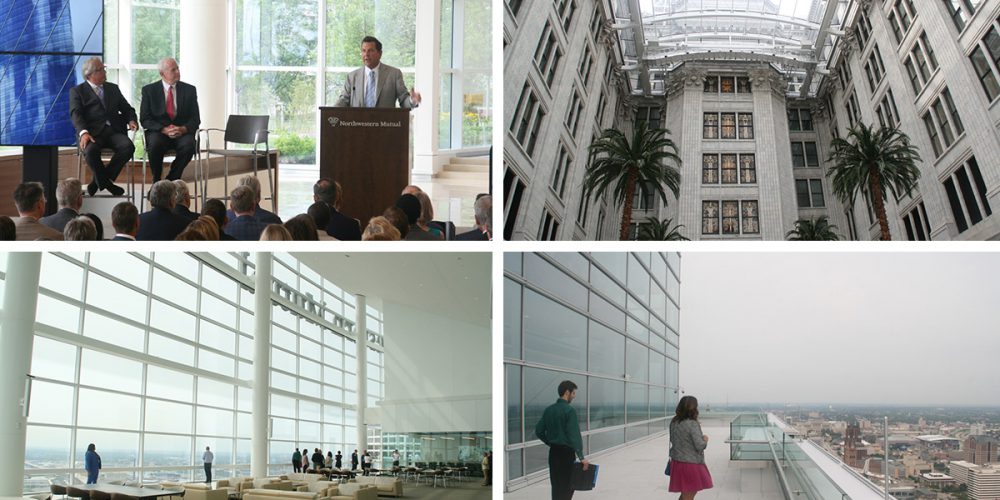The State of TIF in Milwaukee
City has $1.8 billion in incremental value in TIF districts, but do they raise taxes?
It’s getting close to 2020, but the Common Council’s Zoning, Neighborhoods & Development was finally able to accept the 2018 report on tax incremental financing (TIF) districts.
The annual report, originally prepared in June, details the special property taxing districts created by the city and their financial performance.
The city uses the state-regulated districts to pay for public infrastructure, like riverwalk segments, street paving and streetcar construction, and to support projects with financing gaps, including everything from Northwestern Mutual‘s new downtown office tower to affordable housing complexes. Some districts consist of a single property, while others include nearly entire neighborhoods. Districts have a maximum life of 27 years.
The districts take two forms, municipally financed and developer financed. In each case a base value for the included properties is set from current assessments and any incremental property tax revenue above that base level is used to pay off any project costs associated with the district. In the former case, cities bear the risk. If increased values do not materialize, the city must use overperforming districts or its own general-purpose revenue to pay down any associated debt. In the case of a developer financed tax, which works effectively like a property tax rebate, developers front any associated costs and if increased values or any other conditions don’t materialize (often job creation targets), the developer loses out. The latter has been increasingly common in Milwaukee in recent years, especially as a tool to support affordable housing development in the wake of the 2017 federal tax law changes that devalued low-income housing tax credits.
That $1.8 billion figure represents 6.38 percent of the city’s assessed property values and is roughly half of the state-imposed 12 percent TIF limit. From districts closed prior to 2018, $1.3 billion in incremental value has been created and is now on the property tax roll.
Project costs remaining to be recovered from the active districts are pegged at $238.8 million in the Department of City Development (DCD) report. Developer-financed TIF districts are not included in that calculation.
The city dissolved one district in 2015, TID #15 Steeltech, which returned $2.8 million in property value to the tax rolls of the five taxing jurisdictions. That 14-acre district, created in 1991 to support site assembly, environmental clean-up and street improvements for an 186,000-square-foot building for Steeltech Manufacturing at N. 27th St. and W. North Ave., was extended one year with the incremental property tax revenue used to support city housing programs. The city has contributed $2.5 million to the city’s STRONG Neighborhoods Plan program since 2015 by using a provision in state law to extend the life of districts one year and using the proceeds to support housing programs.
TIFs at the end of their life can also be used to pay for street paving projects within a half mile of their boundaries. This year the city anticipates amending the TIF district that funded the Milwaukee Intermodal Station (#60) and TIF #46, which supported the 2002 update to The Shops of Grand Avenue Mall, to pay for paving projects. The latter, which was amended this summer, is being used to fund the city’s contribution to rebuilding N. 2nd St. near The Avenue and Milwaukee Symphony Orchestra‘s new music hall. The Beerline TIF district (#22) is proposed to be used to provide support for the housing program.
Do TIFs Raise Taxes?
TIFs, or tax-incremental financing districts (TIDs) as the city refers to them, have been derided as a tax increase that benefits Downtown, but Alderman Robert Bauman argues the opposite is true.
Bauman asked DCD development projects manager Lori Lutzka, who presented the broader report to the committee, how the districts do or don’t raise taxes.
After Lutzka paused a few times in attempting to offer a succinct explanation, Bauman interrupted. “This is why its difficult to understand because it’s linguistically difficult to do,” said Bauman.
“The tax rate is slightly higher because of tax incremental financing, arguably,” said Bauman. “But, you’re really not increasing taxes as a result of doing tax incremental financing.”
The alderman said that because only property tax revenue that doesn’t exist at the time of approval is being sequestered, no revenue is being foregone by any of the five property taxing entities in Milwaukee (the city, county, school district, technical college and sewerage district). He said this is especially true if the “but for clause” is properly met. The test requires a municipality to identify that the development wouldn’t happen but for the existence of the subsidy. The five entities, through the Joint Review Board, must vote on the creation of each district.
“We are not denying revenue to any unit of government,” said Bauman.
Ald. Russell W. Stamper, II attempted a shorter explanation. “The ultimate goal is for us to receive more money to operate city government,” said Stamper.
He singled out the Northwestern Mutual TIF district, the city’s biggest at $86 million. The district has generated $254 million in incremental value, $30 million more than expected through the end of 2018, and over $6 million more than budgeted in property tax revenue. Those surplus funds will ultimately go towards subsidizing failing districts throughout the city, including the existing Century City district the council debated earlier in the meeting and a series of housing-focused districts.
“I’m not saying this is good or bad, I’m saying the facts should be recognized that the city is investing substantially in central city development,” said Bauman. The alderman has repeatedly argued that the city should invest more aggressively in such development despite the independently-elected City Comptroller noting that such deals, including the Ikon Hotel proposal, have significant risk.
But Alderwoman Milele A. Coggs said Bauman’s logic wouldn’t move minds. “They don’t care about TIDs,” said Coggs of people that testified Monday night at a city budget hearing. “You’re talking about infrastructure. A lot of what they’re talking about is other quality of life stuff.”
Details on each TIF district are available on the city website.
If you think stories like this are important, become a member of Urban Milwaukee and help support real independent journalism. Plus you get some cool added benefits, all detailed here.
Legislation Link - Urban Milwaukee members see direct links to legislation mentioned in this article. Join today
Related Legislation: File 190520
Eyes on Milwaukee
-
Church, Cupid Partner On Affordable Housing
 Dec 4th, 2023 by Jeramey Jannene
Dec 4th, 2023 by Jeramey Jannene
-
Downtown Building Sells For Nearly Twice Its Assessed Value
 Nov 12th, 2023 by Jeramey Jannene
Nov 12th, 2023 by Jeramey Jannene
-
Immigration Office Moving To 310W Building
 Oct 25th, 2023 by Jeramey Jannene
Oct 25th, 2023 by Jeramey Jannene





















